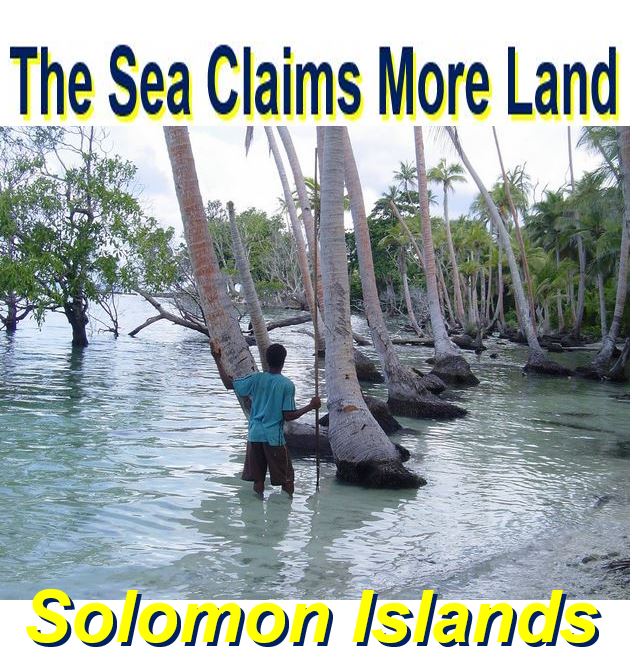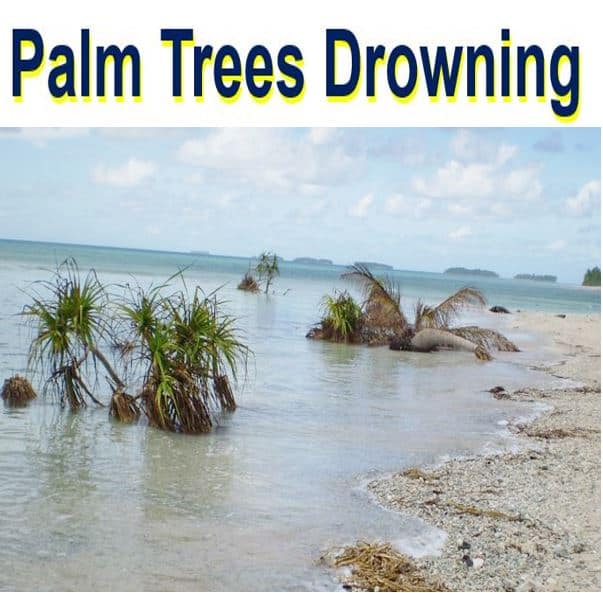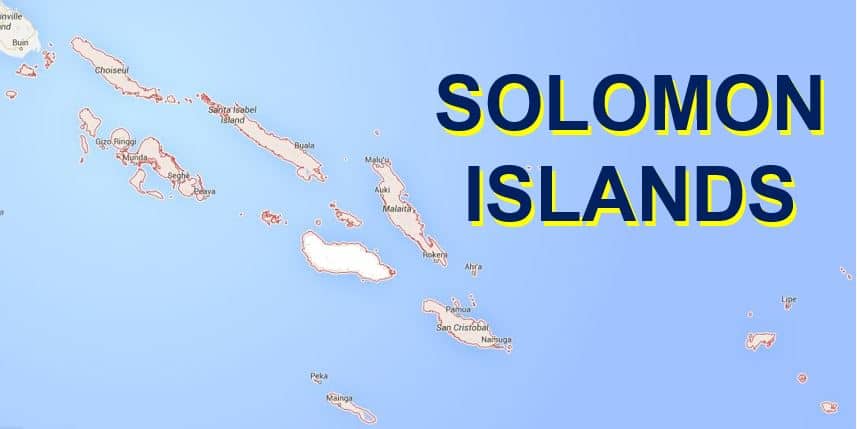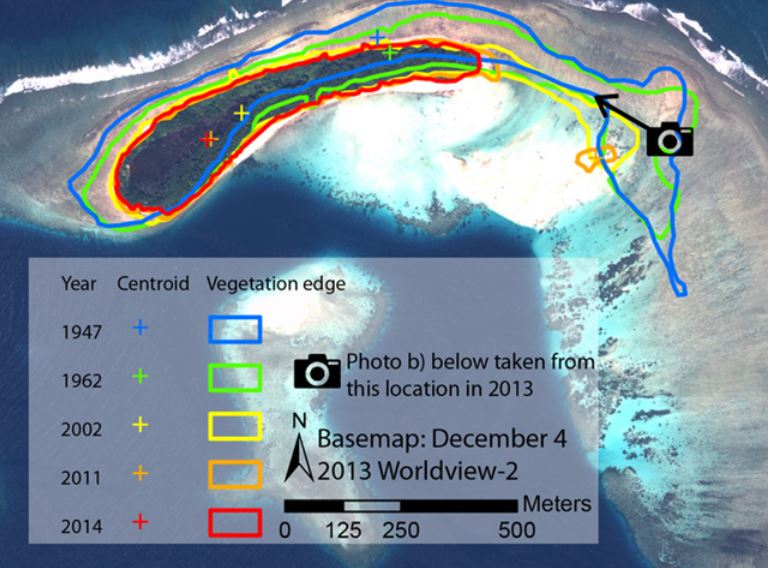Five islands in the remote Solomon Islands in the South Pacific have vanished completely to coastal erosion and sea level rises due to human-induced climate change, a team of scientists reported this week. A further six islands, which have been severely eroded, have a very bleak future.
The Solomon Islands is a sovereign nation consisting of six major islands and 900 smaller islands in Oceania. It is located northwest of Vanatu and to the east of Papua New Guinea. It is a constitutional monarchy with Queen Elizabeth II as its head of state.
 According to the Secretariat of the Pacific Regional Environment Programme: “Studies undertaken under the Australian funded project, the Pacific Islands Climate Change Science Program indicated that sea level has risen near the Solomon Islands by about 8 mm per year since 1993.” (Image: sprep.org)
According to the Secretariat of the Pacific Regional Environment Programme: “Studies undertaken under the Australian funded project, the Pacific Islands Climate Change Science Program indicated that sea level has risen near the Solomon Islands by about 8 mm per year since 1993.” (Image: sprep.org)
Solomon Islands vulnerable to climate change effects
As many of its islands are barely above sea level, much of the country is forecast to disappear as sea levels rise over the next fifty to one hundred years.
The five islands that have been lost to the sea ranged in size from one to five hectares (2.47 to 12.35 acres). They were covered with dense tropical vegetation that was estimated to have been at least 300 years old.
A team of scientists from the University of the Sunshine Coast, the University of Queensland, the University of Wollongong, and CSIRO Oceans and Atmosphere, all in Australia, wrote in the scientific journal Environmental Research Letters (citation below) that their scientific evidence confirms the numerous anecdotal accounts from various parts of the Pacific of the tragic impact of climate change on coastlines and human inhabitants.
A warning to all of us
According to previous studies that examined the risk of coastal flooding in the Pacific region, islands can actually keep pace with rising sea levels, and may even on occasions expand.
 As the sea levels rise people abandon their villages and move inland or uphill, and the plants sink deeper and deeper into the sea and die. (Image: theislandsun.com)
As the sea levels rise people abandon their villages and move inland or uphill, and the plants sink deeper and deeper into the sea and die. (Image: theislandsun.com)
These studies, however, were carried out in areas of the Pacific where sea-level-rise rates were between 3-to-5 mm annually – broadly in line with the world average of 3 mm per year.
The Solomon Islands have seen considerably greater sea-level rises over the past two decades – between 7 to 10 mm per year since 1993, or nearly three times the global average. The scientists say the greater local rate is partly the result of natural climate variability.
These more rapid rates of sea level increases are in line with what scientists expect across much of the Pacific from 2050 until the end of this century, due to sea-level rises caused by anthropogenic (induced by humans) climate change.
Several parts of the Pacific and the rest of the world will experience long-term sea-level-rise rates similar to that already reported in the Solomon Islands, unless we reduce greenhouse gas emissions drastically. Some scientists say it is already too late and that there is nothing we can do to reverse what is soon to come.
The authors – Simon Albert, Colin D Woodroffe, Javier X Leon, Alistair R Grinham, Badin R Gibbes and John A Church – studied the coastlines of thirty-three reef islands using satellite and aerial imagery from 1947 to 2015.
 A map of the Solomon Islands today. What will the map look like in 50 or 100 years’ time? (Image: Google Maps)
A map of the Solomon Islands today. What will the map look like in 50 or 100 years’ time? (Image: Google Maps)
Waves and higher seas – the kiss of death for small islands
They then integrated the data with local traditional knowledge, sea-level records, wave models, and radiocarbon dating of trees.
They found that wave energy plays a major role in the dramatic coastal erosion seen in the Solomon Islands. Islands exposed to higher wave energy were found to have considerably higher loss compared to more sheltered islands that had experienced the same sea-level rise.
The Conversation quoted the authors, who said:
“Twelve islands we studied in a low wave energy area of Solomon Islands experienced little noticeable change in shorelines despite being exposed to similar sea-level rise. However, of the 21 islands exposed to higher wave energy, five completely disappeared and a further six islands eroded substantially.”
 Coastline recession on Sogomou Island between 1947 and 2014. See the photo below for an image of where the camera with an arrow in this picture refers to. (Image: Environmental Research Letters)
Coastline recession on Sogomou Island between 1947 and 2014. See the photo below for an image of where the camera with an arrow in this picture refers to. (Image: Environmental Research Letters)
The ultimate nightmare for many people
These dramatic changes to the shorelines witnessed in the Solomon Islands have driven many communities from their homes – communities that had inhabited these areas for many generations.
The families had to be relocated, which were ad hoc affairs – not relocations led by governments with the support of international climate funds. In other words, the families moved using their own very limited resources and virtually no planning or preparation.
The customary native title (land tenure) system in Solomon Islands has provided some security for displaced residents. In some cases, whole communities have had to abandon coastal villages that were established in the beginning of the last century by missionaries, and retraced their ancestral movements to resettle in old villages inland used by their ancestors.
 This view is from the eroding eastern end of Sogomou Island, looking back towards the remainder of the island. (Image: Environmental Research Letters)
This view is from the eroding eastern end of Sogomou Island, looking back towards the remainder of the island. (Image: Environmental Research Letters)
In other cases, people have had to improvise, with families resettling in small inland hamlets over which they have customary ownership.
Those who can move uphill
Communities with 100 to 200 people have been fragmented into tiny family hamlets. Sirilo Sutaroti, 94, a chief of the Paurata tribe, recently had to relocate. “The sea has started to come inland, it forced us to move up to the hilltop and rebuild our village there away from the sea,” he told the authors.
In an Abstract in the journal, the authors wrote:
“Shoreline recession at two sites has destroyed villages that have existed since at least 1935, leading to community relocations. Rates of shoreline recession are substantially higher in areas exposed to high wave energy, indicating a synergistic interaction between sea-level rise and waves.”
“Understanding these local factors that increase the susceptibility of islands to coastal erosion is critical to guide adaptation responses for these remote Pacific communities.”
Melchior Mataki, Chair of the Solomon Islands’ National Disaster Council, said:
“This ultimately calls for support from development partners and international financial mechanisms such as the Green Climate Fund. This support should include nationally driven scientific studies to inform adaptation planning to address the impacts of climate change in Solomon Islands.”
In April, twelve small Pacific island nations, including the Solomon Islands, signed the Paris climate agreement in New York. “There is a sense of optimism among these nations that this signifies a turning point in global efforts,” the authors said.
It remains to be seen, however, whether the hundreds of billions of dollars pledged will materialize, and how effectively those most at need in remote communities – like the inhabitants of the Solomon Islands – will be helped.
Citation: “Interactions between sea-level rise and wave exposure on reef island dynamics in the Solomon Islands,” Simon Albert, Javier X Leon, Alistair R Grinham, John A Church, Badin R Gibbes & Colin D Woodroffe. Environmental Research Letters. 6 May, 2016. DOI: 10.1088/1748-9326/11/5/054011.
Video – Solomon Islands and the effect of climate change
Island nations, such as the Solomon Islands, have always been vulnerable to extreme weather events. Now climate change is not just increasing the frequency and severity of extreme weather events, it is also making sea levels rise.
